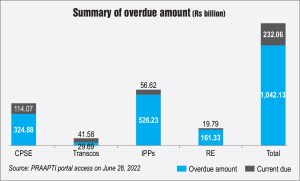
In a first-of-its-kind move to tackle the problem of mounting discom dues, the Ministry of Power (MoP) has allowed discoms to clear their outstanding dues along with late payment surcharge (LPS) in equated monthly instalments (EMIs). On June 3, 2022, the MoP issued the Electricity (LPS and Related Matters) Rules, 2022 wherein the payment of outstanding dues, including principal and LPS accrued up to the date of notification of the rules, will be rescheduled and the due dates redetermined for payment in EMIs of 12-48 months, without further imposition of LPS. However, a delay in the payment of any instalment would attract LPS on the entire outstanding dues.
Delays in payment against power purchase by discoms are the biggest reason for liquidity stress in the power sector. As of May 18, 2022, discom overdues (excluding disputed amount and LPS) stood at Rs 1,000 billion and LPS dues stood at Rs 68.4 billion. According to the power ministry’s initial estimates, (when the power ministry had announced in May 2022 that a one-time relaxation wherein the amount outstanding includes principal and LPS on the date of notification of the scheme will be frozen without further imposition of LPS under the scheme), the scheme will save an amount of Rs 198.3 billion on LPS in the next 12 to 48 months. States like Tamil Nadu and Maharashtra with large outstanding dues will save over Rs 45 billion each, Uttar Pradesh will save around Rs 25 billion while Andhra Pradesh, Jammu & Kashmir, Rajasthan and Telangana will save in the range of Rs 11 billion-Rs 17 billion each.
To recall, this is not the first liquidation scheme or bailout package for the power distribution segment. The earlier one was the liquidity infusion scheme implemented under the Aatmanirbhar Bharat Abhiyan, wherein the central government had extended loans worth Rs 1.35 trillion to clear discom dues. However, its impact was short-lived and outstanding discom dues swelled soon after, owing to liquidity challenges. That said, the latest intervention is different from earlier ones and is expected to ensure better payment discipline in the long term. Sachin Gupta, Executive Director and Chief Rating Officer, CareEdge explains. “Unlike the previous schemes where financing was arranged or liabilities were taken over by the state governments, the recent EMI notification is more of a measure to ensure payment discipline among the discoms. The scheme takes cognisance of the discoms’ inability to make lump-sum payments to clear overdues because of their weak financial position and aims at rescheduling their liabilities towards select creditors. Akin to the August 2019 rule, which made the issuance of a letter of credit mandatory by discoms against power purchase from gencos, these rules will bring in the much-needed payment discipline in the power distribution sector,” says Gupta.
one was the liquidity infusion scheme implemented under the Aatmanirbhar Bharat Abhiyan, wherein the central government had extended loans worth Rs 1.35 trillion to clear discom dues. However, its impact was short-lived and outstanding discom dues swelled soon after, owing to liquidity challenges. That said, the latest intervention is different from earlier ones and is expected to ensure better payment discipline in the long term. Sachin Gupta, Executive Director and Chief Rating Officer, CareEdge explains. “Unlike the previous schemes where financing was arranged or liabilities were taken over by the state governments, the recent EMI notification is more of a measure to ensure payment discipline among the discoms. The scheme takes cognisance of the discoms’ inability to make lump-sum payments to clear overdues because of their weak financial position and aims at rescheduling their liabilities towards select creditors. Akin to the August 2019 rule, which made the issuance of a letter of credit mandatory by discoms against power purchase from gencos, these rules will bring in the much-needed payment discipline in the power distribution sector,” says Gupta.
Details of the Electricity (LPS and Related Matters) Rules, 2022
Order of payment and adjustment and rate of LPS: The LPS will be payable on the payment outstanding after the due date at the base rate for the first month of default. The rate of LPS for the successive months of default will increase by 0.5 per cent for every month of delay. However, the LPS will not be more than 3 per cent higher than the base rate and will not exceed the rate specified in the agreement.
The payments by discoms to gencos/ transcos/trading licensees will first be adjusted towards LPS and, thereafter, towards monthly charges, starting from the longest overdue bill. All the bills payable by a discom will be time-tagged and the payments will be adjusted first against the oldest bill, then the second oldest bill, and so on and so forth.
 Liquidation of arrears: The total outstanding dues including LPS up to the date of notification of the rules will be rescheduled and the due dates will be redetermined for payment by a distribution licensee in EMIs of 12-48 months. The maximum number of EMIs have been offered to discoms with over Rs 100 billion of outstanding dues. At the same time, discoms with dues of up to Rs 5 billion, can pay their arrears in 12 monthly instalments.
Liquidation of arrears: The total outstanding dues including LPS up to the date of notification of the rules will be rescheduled and the due dates will be redetermined for payment by a distribution licensee in EMIs of 12-48 months. The maximum number of EMIs have been offered to discoms with over Rs 100 billion of outstanding dues. At the same time, discoms with dues of up to Rs 5 billion, can pay their arrears in 12 monthly instalments.
The distribution licensee will communicate in writing to the generating company/transmission licensee/electricity trading licensee the outstanding dues and number of instalments in which the dues will be paid within 30 days of the promulgation of the new rules. The first due date for the payment of EMIs will be the fifth day of the immediate month after 45 days from the notification of the rules. The due date for subsequent EMIs will be the fifth day of the subsequent months.
Notably, if the distribution licensee agrees to pay the arrears due as per the instalment fixed under the rule and makes timely payments towards the instalments, then LPS will not be payable on the outstanding dues from the day of the notification of these rules. However, in case of any delay in the payment of an instalment, the LPS will be payable on the entire outstanding dues as on the date of notification of the rules.
Operationalising the payment security mechanism and its consequences: A distribution licensee or user of a transmission system will maintain an unconditional, irrevocable and adequate payment security mechanism. The generating company will supply power only if an adequate payment security mechanism is maintained or an advance payment is made. Otherwise, upon supply of power, the generating company will lose the right to collect the LPS. In case of non-payment of outstanding dues by the default trigger date, the obligation of the generating company to supply power will be reduced to 75 per cent of the contracted power and the balance 25 per cent will be sold through the power exchanges. Furthermore, in case a discom fails to establish a payment security mechanism or continues to default on payment for a period of 30 days, the generating company will be entitled to sell 100 per cent of the power through the power exchanges. During the period of default, the discom will be liable to pay fixed charges/capacity charges, as per the agreement.
Regulation of access to defaulting entities: In case of non-payment of dues, after two and a half months from the presentation of the bill, power supply to the defaulting entity will be regulated. Short-term access for the sale and purchase of electricity, including on the power exchange, will be entirely regulated, including already approved short-term access. The National Load Despatch Centre may, under exceptional circumstances for grid security, temporarily review the regulation of short-term access under the rule. Further, in case dues remain unpaid even after one month of regulation of short-term access, long- and medium- term access will also be regulated by 10 per cent.
Expected outcome and the way forward
 The EMI scheme for the payment of outstanding dues by the discoms is expected to improve the cash visibility for the power sector and inculcate payment discipline among the power discoms. Further, the scheme will provide respite to discoms from the continuous accumulation of LPS. Notably, the timing of the scheme is crucial for the power sector as the country is currently witnessing increasing power demand and inadequate coal availability. The delayed payment by the discoms adds to the woes of the gencos and adversely affects their ability to maintain coal stocks at power plants. It also affects their cash flow, making it difficult to maintain adequate working capital for day-to-day operations, ultimately pushing them into insolvency.
The EMI scheme for the payment of outstanding dues by the discoms is expected to improve the cash visibility for the power sector and inculcate payment discipline among the power discoms. Further, the scheme will provide respite to discoms from the continuous accumulation of LPS. Notably, the timing of the scheme is crucial for the power sector as the country is currently witnessing increasing power demand and inadequate coal availability. The delayed payment by the discoms adds to the woes of the gencos and adversely affects their ability to maintain coal stocks at power plants. It also affects their cash flow, making it difficult to maintain adequate working capital for day-to-day operations, ultimately pushing them into insolvency.
Manish Gupta, senior director, CRISIL Ratings, notes, “With savings of around 25 per cent (Rs 65 billion-Rs 75 billion), the net payout of discoms to gencos is likely to be Rs 200 billion, over and above their yearly cost of power purchase. Funding this additional payout through internal accruals could be a challenge as discoms continue to incur operating losses. But an immediate, one-time additional recovery through tariff or government assistance to at least cover the incremental payouts could help discoms clear their dues this fiscal.” Furthermore, as per CRISIL Ratings analysis, the scheme to liquidate ov-erdues can release past receivables of the renewable energy sector of Rs 90 billion over the next two fiscals. This could improve the receivables period of leading renewable energy gencos by 40-50 days from the current 180 days, and improve the equity returns of some projects by up to 1 percentage point.
Net, net, the objective of the EMI scheme is to ensure the well-being of the power sector. However, the timely payment of instalments by the discoms remains linked to the improvement in their financial position. This requires long-overdue structural changes in the segment pertaining to operational efficiency, and timely tariff revisions, electricity bill payments by government bodies and subsidy payout. Furthermore, the implementation of projects under the Revamped Distribution Sector Scheme, which focuses on network strengthening and expansion, AT&C loss reduction and smart metering, remains key to improving discom efficiencies, going forward.


